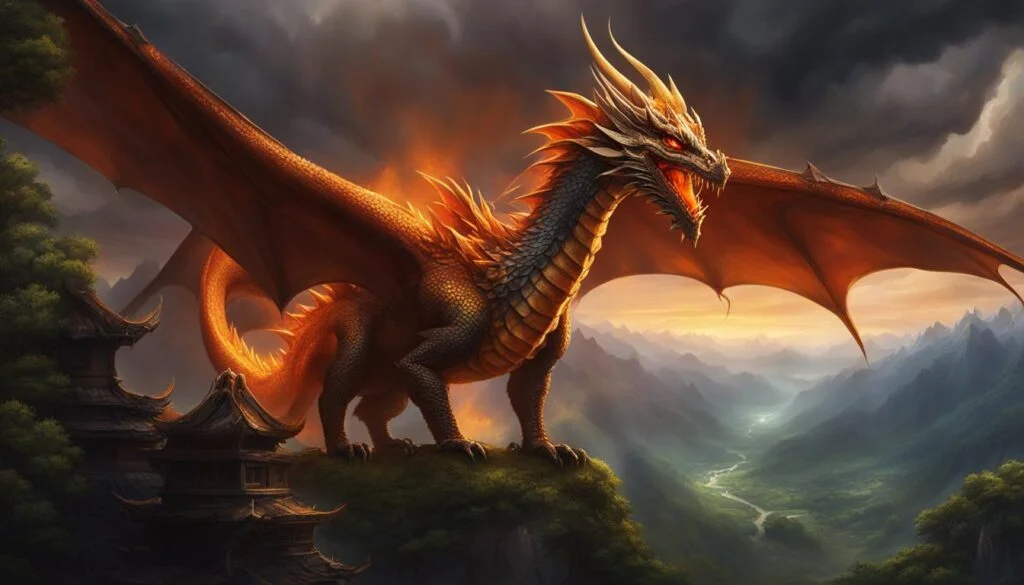Werewolves hold a special place in Norse mythology, with numerous tales and legends featuring these shapeshifting creatures. The stories range from the ancient tale of Sigmundr and Sinfjötli, who don wolf skins and undergo a transformation, to the more symbolic representation of wolves in Norse mythology, such as Fenrir, the son of Loki who plays a pivotal role in Ragnarok. These myths and legends reflect the Vikings’ fascination with wolves and the concept of transformation.
Key Takeaways:
- Werewolves are prominent in Norse mythology, featuring in various tales and legends.
- Sigmundr and Sinfjötli’s story showcases the concept of werewolves in Norse mythology.
- The Vikings had a deep fascination with wolves, evident in their stories and artifacts.
- Wolves held both admiration and fear in Viking society, symbolizing strength and destruction.
- Fenrir, son of Loki, and Odin’s wolves are well-known wolf figures in Norse mythology.
Norse Werewolf Stories: Sigmundr and Sinfjötli
One of the oldest and most popular Viking tales, the story of Sigmundr and Sinfjötli delves into the intriguing concept of werewolves in Norse mythology. This captivating narrative follows the adventures of Sigmundr and his son Sinfjötli as they stumble upon enchanted wolf skins, which bestow them with the ability to transform into wolves.
Once donning the wolf skins, Sigmundr and Sinfjötli undergo a remarkable metamorphosis and embrace their newfound animalistic nature. As wolves, they exhibit extraordinary strength and even engage in fierce battles, drawing upon their primal instincts.
However, the tale also explores the darker aspects of the wolf’s nature. Sigmundr and Sinfjötli, in their wolf form, are unable to completely control the savage instincts that accompany their transformation. Eventually, their untamed impulses drive them to harm each other, highlighting the inherent struggle between strength and destruction symbolized by the wolf.
The story of Sigmundr and Sinfjötli represents the Vikings’ fascination with the duality of the wolf and explores the theme of the human struggle for control over the animalistic side of one’s nature. It serves as a powerful reminder of the complexity of human existence and the delicate balance between strength and self-destruction.
Key Points:
- Sigmundr and Sinfjötli’s tale showcases the concept of werewolves in Norse mythology.
- They find enchanted wolf skins that allow them to transform into wolves.
- In their wolf form, Sigmundr and Sinfjötli exhibit immense strength and engage in battles.
- However, they eventually succumb to the savage nature of the wolf and harm each other.
- The story explores the duality of the wolf as a symbol of strength and destruction, and the struggle for control over one’s animalistic nature.
The Viking Obsession with Wolves
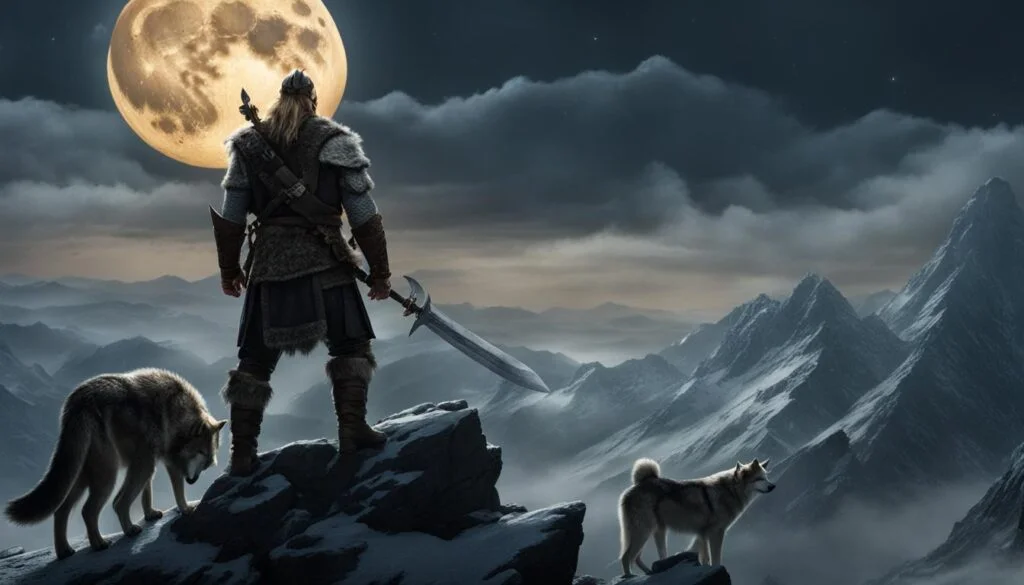
The Vikings were captivated by wolves, which is evident in the numerous werewolf stories and legends they shared. Wolves played significant roles in Norse mythology, symbolizing power, chaos, and the untamed aspects of nature. In battle, Viking warrior bands would sometimes embrace wolf-like behaviors, growling and howling, earning the intimidating monikers “sea-wolves” or “ware-wolves” from their victims. This deep connection between the Vikings and wolves extended beyond mythology to their artifacts. For instance, intricately carved animal-head posts found in Viking burials showcase the reverence the Vikings had for these creatures.
The Symbolism of Wolves in Viking Society
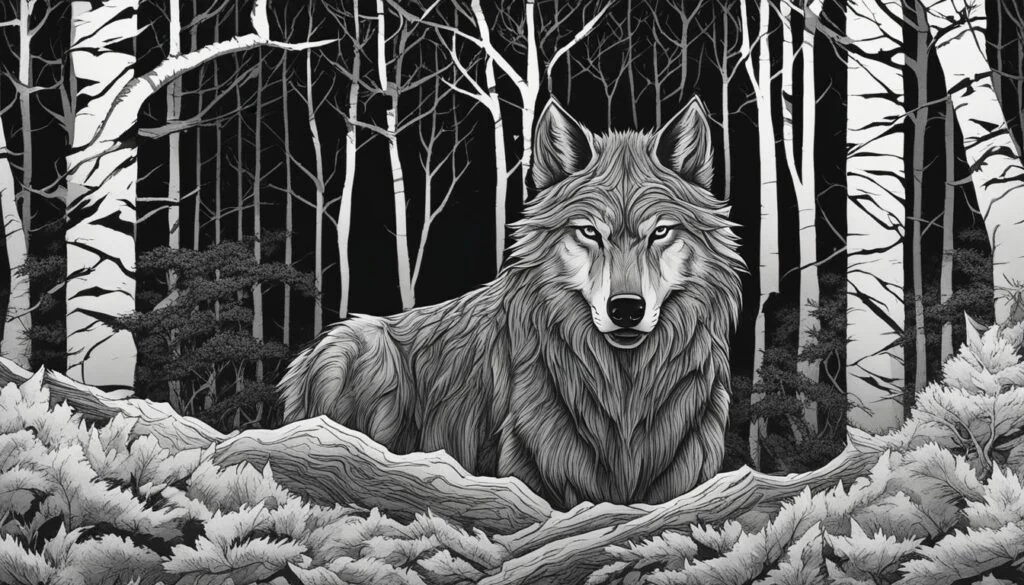
Wolves held both admiration and fear in Viking society. They were seen as creatures that prowled on the edges, embodying destruction and strength. The word for “exile” in Old Norse, vargr, is the same word used for “wolf.” Exiled individuals were considered enemies of mankind, living like wolves in the forest and facing a social death. The Viking social order, similar to wolf packs, had strong alpha males who occasionally worked together but also engaged in blood feuds. The symbolism of wolves in Viking culture reflected the complexity of the animal’s nature.
- Wolves represented both destruction and strength in Viking society.
- The Viking word for “exile” is the same as the word for “wolf”, highlighting the association between outcasts and these apex predators.
- Viking social structure, much like wolf packs, consisted of strong alpha males who sometimes collaborated but also fought each other.
- Wolves symbolized the fine balance between chaos and order within Viking culture.
The Wolf in Norse Mythology: Fenrir and Odin’s Wolves
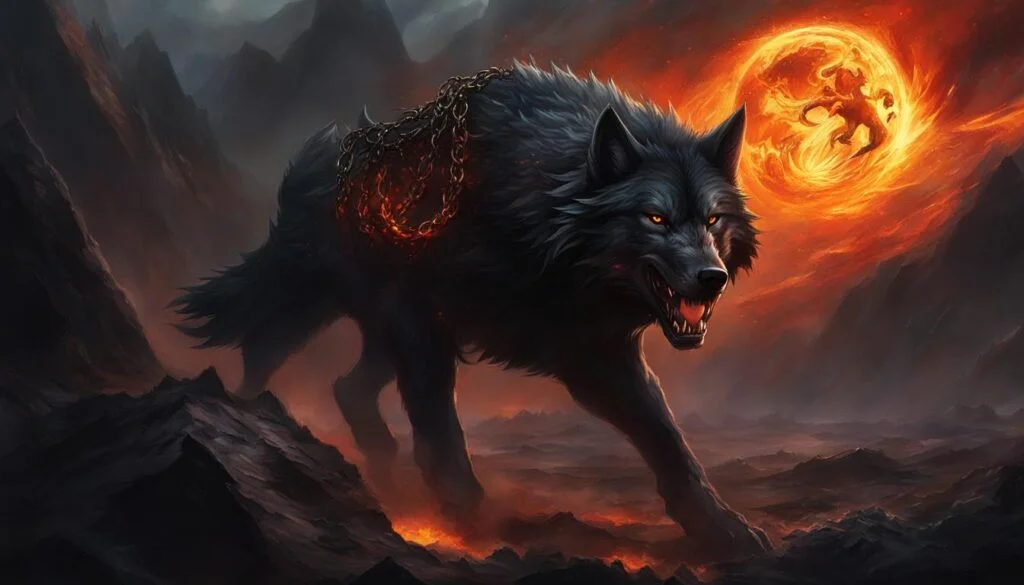
The most well-known wolf in Norse mythology is Fenrir, the son of Loki and the giantess Angerboda. The gods bound Fenrir in chains, knowing that he would break free during Ragnarok, the Viking doomsday. Fenrir’s role in the apocalypse includes devouring the sun and killing Odin, the king of the gods.
Odin himself is often depicted with two wolves, Geri and Freki, who are said to accompany him everywhere. The connection between Odin, wolves, and even Fenrir demonstrates the duality of their symbolism in Norse mythology.
In Norse mythology, wolves represent power, chaos, and the untamed force of nature. Fenrir’s insatiable hunger and destructive capabilities embody the fierce and brutal aspects of the wolf. Odin’s wolves, on the other hand, symbolize loyalty and companionship.
Geri and Freki are often depicted as Odin’s faithful companions, reflecting the bond and symbiotic relationship between the god and the wolf. They serve as an extension of Odin’s strength and wisdom, accompanying him on his journeys and in battle.
This depiction of wolves in Norse mythology highlights the dual nature of these creatures, encompassing both the destructive and the protective qualities often associated with wolves.
Ulfhéðnar: Viking Wolf Warriors

The Vikings had a class of elite warriors known as úlfhéðnar, or wolf-skin warriors. These formidable fighters would dress in wolf skins and unleash their inner beasts on the battlefield. Adorned in the pelts of these fearsome creatures, the úlfhéðnar would exhibit wolf-like behaviors, striking fear into the hearts of their enemies.
Accounts of their ferocity suggest that these warriors fought with their bare hands, relying on their own physical strength and fearlessness. They embraced the chaos of battle, often entering a frenzy that gave them an edge against their opponents. In the heat of battle, some úlfhéðnar were even known to turn on their own allies, driven by an uncontrollable bloodlust.
These Viking wolf warriors were revered for their brutal prowess and feared by those who encountered them on the battlefield. They were devotees of Odin, the Norse god of war, and believed to possess a deep connection with the spirit of the wild animal. The úlfhéðnar symbolized the raw power and primal instincts that resonated with the Viking culture.
Werewolves in Norse Sagas
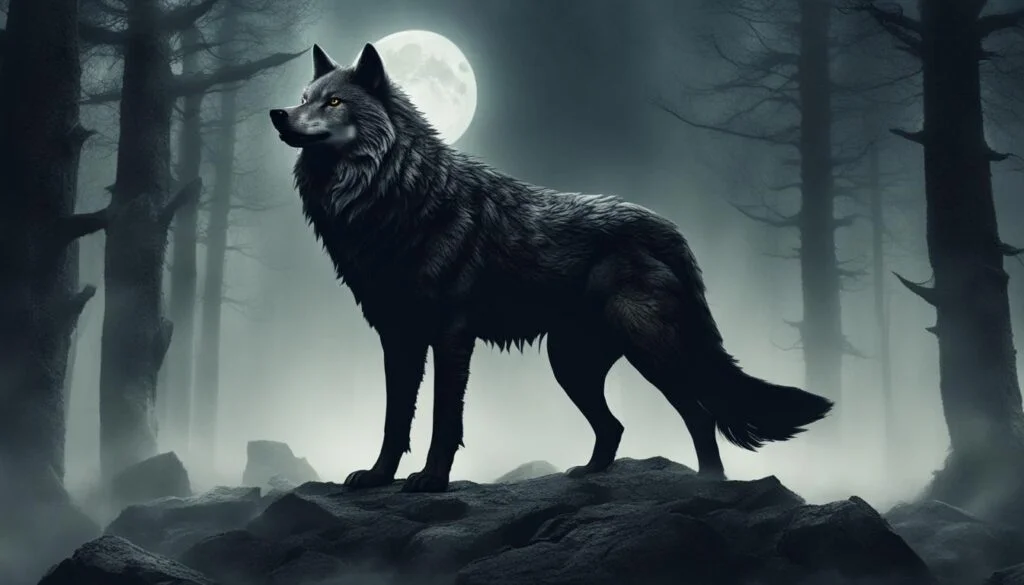
Werewolves play a prominent role in Norse sagas, underscoring the widespread belief in their existence within Viking culture. These captivating tales, such as the Vǫlsunga Saga, feature werewolves as central characters, delving into their transformative power and the eternal struggle to control the primal beast within. These sagas often depict individuals stumbling upon enchanted beings or themselves becoming werewolves, offering insights into the potential connections between outlaws, shamanism, and the wolf transformation in ancient Norse folklore.
The Vǫlsunga Saga
In the epic saga, the Vǫlsung family encounters numerous supernatural beings, including werewolves. The protagonist, Sigmundr, and his son, Sinfjötli, find themselves transforming into wolves after discovering enchanted wolf skins. Through their transformation, the saga explores the profound duality of the wolf’s nature and the inevitable clash between their newfound strength and the destructive instincts they possess. This captivating tale delves into the complex relationship between humans and the animalistic forces that reside within them, echoing the Viking fascination with the power and wildness of wolves.
Outlaws, Shamanism, and Wolf Transformation
The presence of werewolves in Norse sagas often intertwines with themes of outlaws and shamanism. Outlawed characters frequently undergo wolf transformations, embodying their marginalization from society and their connection to the wilderness. This symbolism reflects the belief in the transformative power of the wolf and its potential influence on those who defy societal norms. Furthermore, the connection to shamanism suggests a spiritual link between humans and the animal realm, where shape-shifting becomes a vessel for experiencing and channeling the animal’s inherent power.
The Struggle for Control
The werewolf tales within Norse sagas emphasize the ongoing struggle for control over the animalistic instincts within humans. The protagonists grapple with the dichotomy of their dual existence, torn between their human consciousness and the uncontrollable bestial nature that emerges during the transformation. This internal battle highlights the eternal struggle to tame and harness the power of the wolf, showcasing the Viking’s fascination with exploring the complex interplay between strength, wildness, and self-control.
Werewolves in Norse sagas serve as captivating narratives that exude the Vikings’ deep-rooted belief in the supernatural and their exploration of the human-animal connection. These stories provide insight into the cultural landscape of the Viking era, where the allure of mythical transformations and the untamed power of the wolf became central themes in ancient Norse folklore.
European Perceptions of Vikings as Werewolves
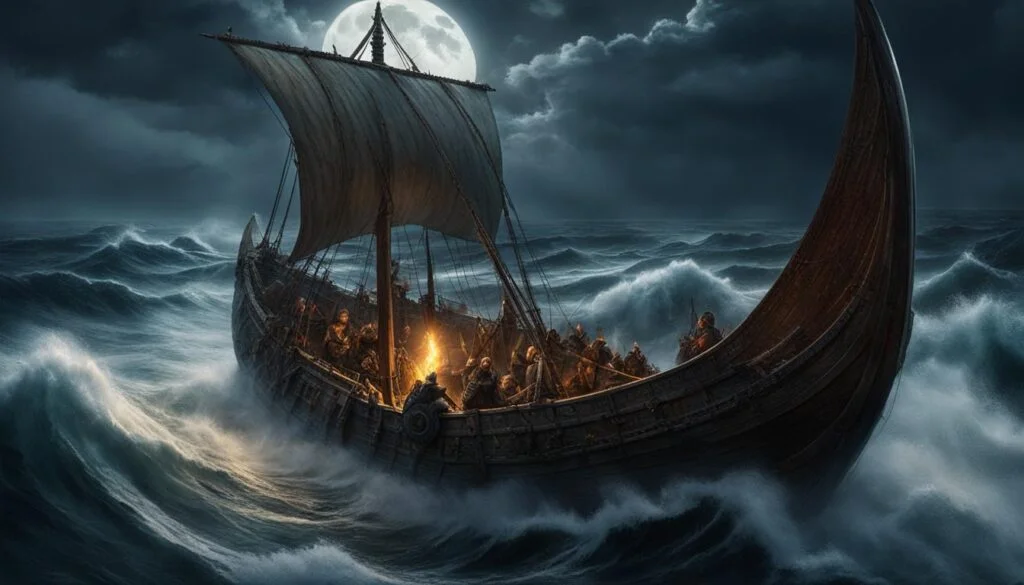
During the Viking Age, European civilizations targeted by Viking raids often portrayed the Vikings as “sea-wolves” or “ware-wolves” in their historical records. These metaphors were used to equate the Vikings with the savage and destructive nature of wolves, depicting them as fearsome warriors and formidable foes.
This association of the Vikings with werewolves served to further demonize their image and emphasize their brutality in the eyes of the Europeans. The Viking raids were seen as wolf-like attacks, characterized by swift and devastating strikes that left a lasting impact on the affected regions.
The European perception of the Vikings as werewolves not only reflected the terror and fear evoked by their raids but also highlighted the Viking warriors’ formidable reputation. The Vikings’ relentless onslaught and their unwavering determination to conquer and pillage were likened to the primal instincts and ferocity of the wolf. This portrayal reinforced the notion that the Vikings were a force to be reckoned with, capable of wreaking havoc and instilling fear in the hearts of their enemies.
However, it is important to note that these European perceptions were largely influenced by the accounts of the victims of Viking raids and were fueled by the desire to vilify and dehumanize the Vikings. The Viking raids, although ruthless and destructive, were driven by various factors, including political and economic motivations, rather than a literal association with werewolves. Nevertheless, the European perception of Vikings as werewolves played a significant role in shaping their overall image and reputation.
Historical Evidence of Viking Werewolves
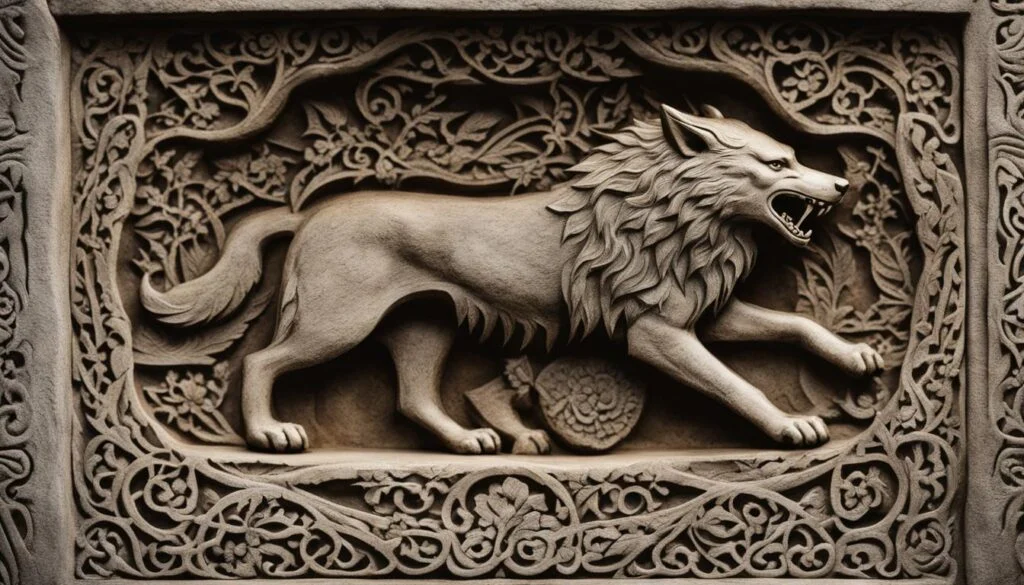
Archaeological finds provide compelling historical evidence supporting the existence of Viking werewolves. These fascinating discoveries offer insight into the Vikings’ belief in the supernatural and their connection with wolves.
One significant piece of evidence is the elaborately carved animal-head posts found in Viking burials. These artifacts depict figures adorned with wolf pelts, emphasizing the close association between Vikings and wolves. The intricate carvings beautifully capture the power and symbolism of these mythical creatures.
The Ulfhéðnar, a class of Viking wolf warriors, also contribute to the historical evidence of Viking werewolves. These elite warriors would dress in wolf skins, embodying the essence of the wolf both in appearance and behavior. They fought with exceptional strength and fearlessness, drawing strength from their connection with the spirit of the wild animal.
The legends and sagas passed down through generations further reinforce the belief in werewolves among the Vikings. These mythical stories depict individuals stumbling upon enchanted objects or undergoing transformations themselves, showcasing the Vikings’ fascination with shapeshifting and the struggle between human and animal nature.
The combination of these artifacts, legends, and sagas provides a solid historical foundation for the existence of Viking werewolves. They highlight the Vikings’ rich cultural heritage, profound reverence for the power of nature, and their exploration of the intricate relationship between humans and animals.
Shapeshifting and Power in Norse Mythology
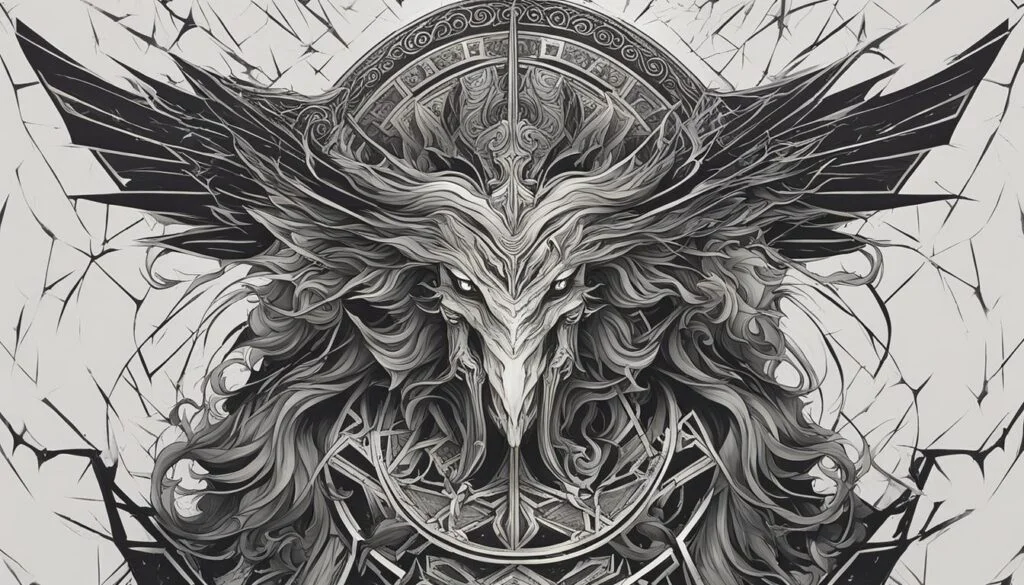
Shapeshifting is an integral aspect of Norse mythology, where gods, giants, dwarves, and even humans possess the ability to transform into animals. This concept extends to the realm of werewolves, exploring the profound connection between power, transformation, and the untamed essence of nature. The act of shapeshifting symbolizes a spiritual link to the animal world and is often associated with tales of immense power and sacrifice.
In Norse mythology, the capacity for shapeshifting embodies the belief in the fluid boundary between humans and animals, blurring the line between the mortal and the divine. It reflects the complex relationship between humans and the natural world, where the ability to assume the form of an animal represents a deep understanding and communion with the animal’s essence.
Shapeshifting in Norse mythology often accompanies tales of gods, such as Odin, assuming the form of a bird or animal to acquire wisdom or navigate different realms. This transformative power bestows them with greater insight, influence, and control. The ability to shift between forms grants individuals unparalleled power and facilitates their navigation through various challenges and conflicts.
Moreover, shapeshifting in Norse mythology frequently involves sacrifice — a means of obtaining or harnessing power. Transformation implies a surrender of one’s human form, assuming the characteristics and strengths of another being, often at great personal cost. This symbolic sacrifice is an essential aspect of the shapeshifting narrative, highlighting the transformative power of both physical and spiritual change.
Power and Its Manifestation
In Norse mythology, power manifests in various forms, ranging from physical strength to supernatural abilities. Shapeshifting represents a unique type of power, one that encompasses adaptability, unpredictability, and the ability to transcend limitations. The capacity to change shape symbolizes mastery over oneself and the world around them.
Werewolves, as supernatural beings capable of shifting between human and wolf forms, embody this power in Norse mythology. The transformation into a powerful and fearsome creature conveys the ability to tap into primal instincts and harness their strength. Werewolves symbolize the integration of the civilized and wild aspects of existence, a balance between the human and animal within.
The shapeshifting motif also highlights the nuanced understanding of power in Norse mythology. It suggests that true power lies not in dominion or control, but in the ability to adapt, transform, and find harmony within the flow of existence. The transformative nature of shapeshifting implies a deeper connection to the fundamental forces of the universe, emphasizing the importance of balance, growth, and evolution.
Conclusion
Werewolves in Norse mythology capture the Vikings’ deep fascination with wolves, shamanism, and the transformative power of animals. These creatures feature prominently in various legends, such as the tales of Sigmundr and Sinfjötli, who don wolf skins and undergo a remarkable metamorphosis. The symbolism of werewolves reflects the Vikings’ understanding of the duality between human and animal nature, as well as the struggle for control over one’s primal instincts.
Furthermore, werewolves in Norse mythology are not mere figments of imagination but serve as a reminder of the complex society the Vikings inhabited. The legends surrounding werewolves reflect the Vikings’ belief in the supernatural and their exploration of the spiritual connection between humans and animals. Through these stories, the Vikings sought to understand the power dynamics within their society, paralleling the intricate relationships among wolf packs.
In essence, werewolves in Norse mythology represent the rich cultural heritage of the Vikings and their profound connection to the natural world. By delving into the world of werewolves, the Vikings not only celebrated their reverence for wolves but also delved into the mysteries of transformation and the interplay between human and animal nature. As we unravel the depths of Norse mythology, we uncover a world where werewolves symbolize the primal forces that shape our understanding of power, chaos, and the intricate tapestry of human existence.
FAQ
Did Norse mythology have werewolves?
Yes, werewolves hold a special place in Norse mythology, with numerous tales and legends featuring these shapeshifting creatures.
What are some werewolf stories in Norse mythology?
One of the oldest and most popular Viking tales is the story of Sigmundr and Sinfjötli, who don wolf skins and undergo a transformation into wolves.
What was the symbolism of wolves in Viking society?
Wolves in Viking society represented power, chaos, and the wild side of nature. Viking warrior bands would sometimes adopt wolf-like behaviors in battle, earning them the nickname “sea-wolves” or “ware-wolves”.
Who is Fenrir in Norse mythology?
Fenrir is a wolf and the son of Loki and the giantess Angerboda. He plays a pivotal role in Ragnarok, the Viking doomsday, where he breaks free and brings destruction, devouring the sun and killing Odin.
Were there Viking warriors known as wolf-skin warriors?
Yes, there were elite Viking warriors called úlfhéðnar, or wolf-skin warriors, who would dress in wolf skins and exhibit wolf-like behaviors in battle.
Are there werewolf tales in Norse sagas?
Yes, werewolves make frequent appearances in Norse sagas, exploring the transformative power and the struggle to control the beast within.
How were the Vikings perceived as werewolves by European civilizations?
European civilizations targeted by Viking raids often referred to the Vikings as “sea-wolves” or “ware-wolves” in their historical records, equating them with the savage and destructive nature of wolves.
Is there historical evidence of Viking werewolves?
Yes, artifacts such as the elaborately carved animal-head posts found in Viking burials depict figures wearing wolf pelts, supporting the belief in werewolves among the Vikings.
What role does shapeshifting play in Norse mythology?
Shapeshifting is a significant aspect of Norse mythology, with gods, giants, dwarves, and even humans capable of transforming into animals, symbolizing power, transformation, and the wild side of nature.
What is the significance of werewolves in Norse mythology?
Werewolves in Norse mythology represent the Viking fascination with wolves, shamanism, and the transformative power of animals, reflecting the complexity of Viking society and their beliefs in the supernatural.




